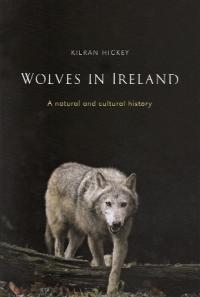Wolves in Ireland—a natural and cultural history
Published in 18th-19th Century Social Perspectives, 18th–19th - Century History, Book Reviews, Early Modern History (1500–1700), Early Modern History Social Perspectives, Issue 1(Jan/Feb 2012), Medieval History (pre-1500), Medieval Social Perspectives, Pre-Norman History, Pre-Norman Social Perspectives, Reviews, Volume 20
Wolves in Ireland—a natural and cultural history
Kieran Hickey
(Four Courts Press, €29.95)
ISBN 9781846823060
The wolf is as rich an image in literature as it is a reality—albeit a persecuted one—in natural history. Invariably featured as a menace in mythology and folklore, the wolf, demon or hero, is a strange and glamorous creature, the enigmatic ancestor of our domestic dog, and still roams Russian Asia, Canada and Alaska.Anyone with an interest in the subject will be excited by geographer Kieran Hickey’s academic monograph. It is not, however, a book for the general reader. It is informed and informative as well as fuelled by an obvious passion that Hickey’s business-like prose lacks. Anyone drawn to wolves, particularly the wolf in Ireland, will want to read it; the difficulty is that if you are already keen you will be familiar with the material and this will cause you to pick holes in the style and presentation, which is marred by repetition and an almost random—and this is not a casual, anecdotal account—arrangement of the facts. For example, on p. 52 we read: ‘In an illustration for the printing of “Inisfree”, Jack Yeats depicts his brother W.B. Yeats dressed up as an ancient Irish warrior complete with wolf skin’. A mere fourteen pages earlier, on p. 38, Hickey has already stated: ‘William Butler Yeats was interested in the Fianna and, for a printing of his poem “Inisfree”, he was depicted dressed up as an ancient Irish warrior complete with wolf skin’. Why not just add here that his brother was the artist?Similarly, on p. 49 Hickey writes: ‘One of the most surprising aspects of the survival of large numbers of wolves in Ireland long after they had been exterminated in England and Wales is that the country became known as wolf-land’. Twenty pages earlier, he writes: ‘Most remarkably of all, Ireland was sometimes known as “Wolf Land” because of the number of wolves in the country long after they were gone from England’. In one reference, ‘wolf land’ appears in upper case without the hyphen, in the second in lower case with a hyphen; either way, it raises the problem of inconsistencies in the basic editing as well as stylistic shortcomings.Hickey is not sufficiently clear on whether or not the Irish wolfhound was bred to deal with wolves, and, if so, how the breed was established. The wolf’s resilience and ability to survive got him to Ireland in the first place, and his hunting of local cattle and wild pigs sustained him, until the farmers took more care in the sheltering of their stock. But what kind of Ireland? And why doesn’t Hickey elaborate?The two factors that had the most impact on the Irish wolf were closely associated. First, there was the destruction of the native forest, which reduced the wolf’s habitat and protection. The subsequent plantations and the arrival of Cromwell were also significant. English settlers were not prepared to tolerate wolves, animals that had been extinct in England and Wales since the fourteenth century. The Cromwellians introduced bounties on wolves. It is interesting that most of the place-names that include the word ‘wolf’ or are associated with wolves are found in Ulster, with other concentrations in Laois and Offaly.Attempting to write a study on an animal known to have been extinct in this country since 1786, when the last wolf was famously killed in Carlow, is an ambitious undertaking, particularly without any DNA to support a thesis. Also problematic is the fact that all the photographs, including the cover shot, were taken of wolves in captivity at Dublin Zoo. Perhaps there is an intended irony about that? But this is not an ironic book and the layout is utterly lacklustre. My couple of sightings of wolves in the wild as a child in California are among the most dramatic memories of my life. Yet therein lies a question about this earnest and laboured book. Kieran Hickey blends his material too closely and it is easy to simply fall into discussing wolves in general, with the emphasis falling on the extensive material relating to the grey wolf. The native North American wolf is a species with a far wider—and physically larger—range of prey, including moose, bison and wild horses, as well as deer. The Irish wolf would also have had deer to hunt, and unprotected cattle. It is odd to think that a sighting of a wolf in Ireland would once have been as common as is a fox now.Well represented in mythology as the wolf is, Hickey notes that ‘there is a surprising lack of drawings, paintings, detailed written descriptions and stuffed specimens, not even a head survives’. Because of its isolation, the Irish wolf may well have developed into a distinctive subspecies. One could imagine that the Irish wolf was physically smaller than its North American and mainland European counterparts. Reintroduction is, as Hickey suggests, not feasible. Ireland is now far more populated and the woodland cover far more scarce than it was when the Irish wolf roamed freely.A multidisciplinary study of the wolf calls upon the geographer (as Hickey is), the archaeologist, the historian and the natural scientist. The scene should be set and it is vital to evoke the Ireland of the mid- to late medieval period. It is an exciting project and requires prose and visuals to match. Kieran Hickey has written an important book but it could have been a better, more persuasive one. The wolf inspires passion; this text has none. HI
Eileen Battersby is Literary Correspondent of the Irish Times and author of Ordinary dogs (Faber).
















